Shiny.
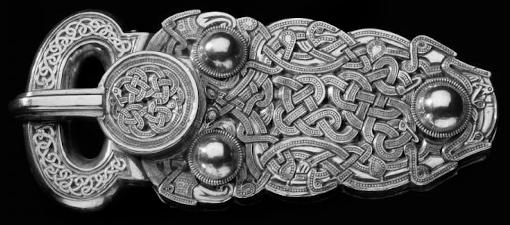
We watched The Dig over the weekend, the Netflix dramatization of the dig for Sutton Hoo just before the outbreak of WWII. It was 4/5 a brilliant film that somehow decided to spend its last twenty minutes tying up a minor subplot I didn’t give a shit about. With any luck, there will be a director’s cut with that excised.
Still a recommend.
They worked with the British Museum to get the costumes and sets right. There’s an interesting blog post from the BM here that describes the process. Spoilers, I guess.
And you can take a virtual walk around Room 41 that they’ve somehow built using Google Street View technology.
Very cool.
February 2, 2021 — 8:09 pm
Comments: 12
‘Tis but a scratch
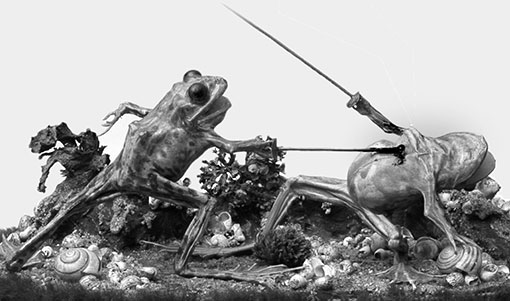
This charming example of Victorian taxidermy – and my charming, I mean disgusting – was in the collection of Louis Mantin, a wealthy eccentric from Moulins. He built an entire mansion around his art collection. Not all of it in execrable taste.
When he died in 1905, he willed the property to the town – on the condition they put it on display and change nothing inside. He wanted people a hundred years hence to see “a specimen of a bourgeois home of the nineteenth century.”
It’s not clear to me that he meant to board it up and completely neglect it for a century, but I haven’t seen the will with my own eyes. Anyway, that’s what they did. Boarded it up and let it gently rot.
After pouring a bunch of money into it again, it opened to the public in 2010. NatGeo has a short slideshow, but you’ll probably see more on an images search.
What it is to have money, with or without taste. Good weekend, all!
Oops! I didn’t hit publish on this last night! Happy Caturday, folks.
January 30, 2021 — 1:10 pm
Comments: 5
Here’s that pitcher of dicks you ordered, ma’am
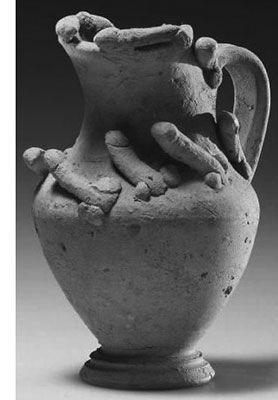
Standing erect in the stream of Twitter archaeology news every week, we find the #PhallusThursday hashtag.
I feel like there’s a joke here that I’m not getting. Like the word for penis and the word for the fourth day of the week rhyme in ancient Assyrian or something and the PhD archaeologists are laughing at me for not knowing that.
But it’s probably just a cheap opportunity to post dick pics on Twitter.
Try it if you need a break from following #stonks, #GameStop and #robinhood. Phew!
Hey. HEY! I can quit Twitter any time I want.
I’ve had the theme from Phyllis stuck in my head all day. I was a fan. Particularly of that theme song. RIP Cloris Leachman.
January 28, 2021 — 8:53 pm
Comments: 12
Lion optional
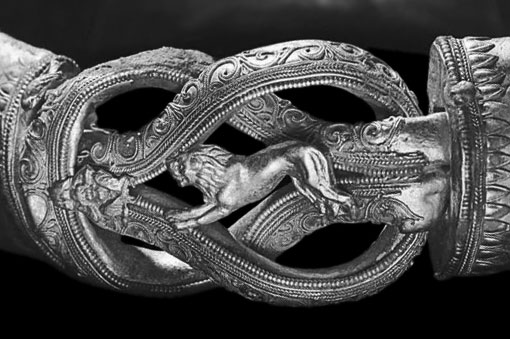
We are having a jolly conversation about metalworking in the thread below. BJM says he used to work silver wire and Thracian “Herakles knot” arm bands were a popular item.
I have a new rule under lockdown. Any word or phrase I don’t understand, I immediately stop and look it up. There’s really no excuse not to now, when you can highlight, right click and search all in one swell foop.
Heracles knot is another word for reef knot (AKA square knot, Hercules knot, double knot or brotherhood knot). In jewelry, it is a symbol of love or friendship.
I don’t know how it’s associated with Heracles. I didn’t spend much time looking, though – it’s bath night!
A warning from the International Guild of Knot Tyers (yes, there is):
The International Guild of Knot Tyers warns that this knot should never be used to bend two ropes together. A proper bend knot, for instance a sheet bend or double fisherman’s knot, should be used instead. Knotting authority Clifford Ashley claimed that misused reef knots have caused more deaths and injuries than all other knots combined.
I woke up in a good mood today. No, it didn’t make any sense to me, either, but I held onto it as best I could by avoiding social media. Mostly.
January 20, 2021 — 9:22 pm
Comments: 9
Stare at this beautiful thing!
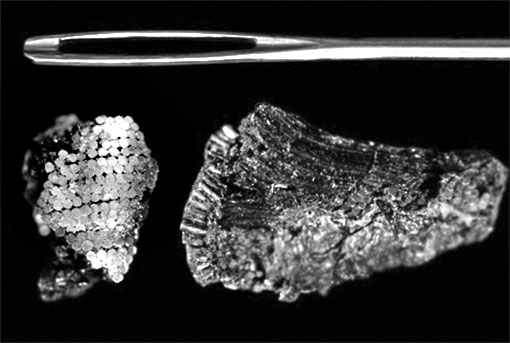
This is part of the pommel of a sword dug up in 1808 from Bush Barrow, a Bronze Age burial mound half mile from Stonehenge. It’s about 4,000 years old.
Let me ‘splain what you’re looking at. The craftsman extruded a wire a bit thicker than a human hair, snipped off a millimeter of it and flattened the end to make a stud. Like a tiny golden nail. You can see them side-on in the image bottom right.
Then he poked a hole for the nail in a wooden pommel and stuck it in the hole with a resin adhesive. This would have required some sort of awl and some sort of tweezers – these things are way too small for human fingers.
There would have been maybe 140,000 of these tiny gold nails in the final piece, which would have taken an estimated 2,300 man-hours. Yes, I am defiantly using the expression ‘man-hours’.
The article doesn’t say so, but it would have sparkled magically.
The article also quotes an “expert on the optics of the human eye” who said only children or people who ruined their eyesight as children could have done this work, which would impair them for life.
I thought we’d been told that was a myth; that you don’t ruin your eyesight making lace. My optometrist told me it wasn’t so much that my eyesight was deteriorating, as that it was more and more fixed at the distance I used most (i.e. computer screen distance).
Anyway, take it from myopic me; it wouldn’t have impacted life all that much. I go around without my glasses most of the time and life is a pleasant soft and gauzy haze. Minimal bruises.
I tried to find a better site for this story than Ancient Origins, which seems like an ‘aliens invented underpants’ sort of place, but I failed. I also spent quite a while trying to find a YouTube to explain how the ancients made fine gold wire. All the demonstrations of wire-making I could find involve blowtorches and a tool-and-die works. No success so far.
January 19, 2021 — 8:30 pm
Comments: 14
Huh. Actual cavemen carried actual clubs.

Meet the Thames Beater, a 5,000 year old club fished out of the river. The top one; the bottom one is a reproduction they used to beat up test dummies. Turns out, it’s deadly.
Actual study here.
I had to step away from social media today. It was making me ill.
I mean, I peeked a few times, sure.
January 13, 2021 — 8:16 pm
Comments: 8
What am I?
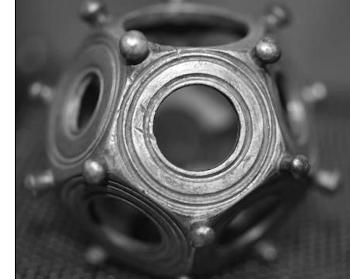
This is a Roman dodecahedron and nobody knows why.
Over a hundred of them have been found, sometimes with hoards of coins. So they had a value. They have been found across Europe and Britain, but not in Italy. They would have been pretty work-intensive to make.
They are hollow cast objects with twelve flat pentagonal faces. Each face is pierced with a hole. The holes vary in shape in pairs (the hole opposite is the same size). The corners have knobs braised on. They are made of an alloy. They range in size from one and a half to four and a half inches. Here are some images.
The best guess is candlestick holder, since two were found with wax inside. I’m inclined to this one, though I’d like to know whether they had teeny candles.
Other guesses are to measure the width of something or the size of things at a distance, though there’s an awful lot of variation for that.
Game pieces, but you couldn’t throw them like dice. The differently-sized holes would make them fall not-randomly.
Purely ornamental, like cane toppers. Seems unlikely to me, since they are so uniform in design and construction.
It’s been puzzling me all afternoon. It can go puzzle you for a while.
November 27, 2020 — 7:15 pm
Comments: 18
Guess how we’re going to celebrate?

Today is the 100th anniversary of the Volstead Act, the law that put the teeth in the 18th Amendment. I speak, of course, of Prohibition. Interesting article about it here.
I know it was a disaster, but to be honest, I kind of admire us for trying. No way human beings would give up the joy of alcohol after who-knows-how-many millennia, but it’s neat that we did something so weird and radical and stupid with such grand American enthusiasm. Yay us.
Nobody quit drinking for long, of course. There were several loopholes.
Sacramental wine. Demand went up by 800,000 gallons a year.
Prescription whisky for them as could afford regular Doctor visits.
You were allowed to drink any alcohol you already owned when the law went into effect, so one wealthy judge reportedly bought a lifetime supply up front.
Poor people began to drink patent medicines and hair dyes and industrial alcohols and all kinds of dangerous and potentially fatal things.
And that’s before we get to smuggling, bootlegging and bathtub gin.
Oh, we drank. And we shall drink again. Good weekend, everyone!
January 17, 2020 — 9:39 pm
Comments: 9
No, it’s not a poop

Did you see this story today? This is the 5,700 year old wad of gum that scientists in Denmark have used to analyze an ancient woman’s DNA.
Based on the findings, she had dark hair, dark skin and blue eyes. I wonder what the relationship is between her and modern Danes and why that combination is rare now?
They also were able to sequence some bacteria from her mouth and ascertain her meal before chewing gum included duck and hazelnuts.
Not exactly gum. It was birch sap, which has some antibacterial properties that help preserve all this junk.
There were some related articles about things they’ve learned about the prehistoric diet from analyzing tooth plaque, but most of the links I hit were behind the paywall. I used to read Science News religiously in the States. Every time I think I’ll break down and buy a subscription, they run another article on global warmening and it gives me a sad.
December 17, 2019 — 8:54 pm
Comments: 6

The Vasa was a Swedish warship launched in 1628. On its maiden voyage, it sailed not quite a mile from port and sank like a rock. It was rediscovered in the 1950s, almost entirely intact (the cannons had been salvaged in the 1700s).
You’ve probably heard of it, but a neat Twitter thread about it floated across my feed tonight, which led me to the museum’s official website. Well worth an hour’s happy browse, I say.
Hello! We survived Monday!
July 29, 2019 — 9:31 pm
Comments: 6












